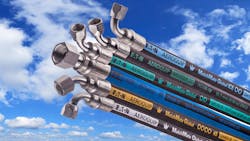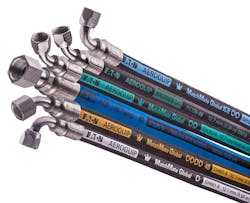Why Do Some Hydraulic Hoses Outperform Others?
Operational environments and application demands for hydraulic hoses are vast and varied. From snowplows in cold Canadian winters to the hot interior workings of industrial machinery, hydraulic hoses perform a great number of functions the modern world depends on.
Each of these hose applications has one thing in common: Failure is not an option. Unreliable hoses can cost companies millions of dollars in downtime on critical equipment. A failed hose on a transit bus can strand dozens of commuters for hours. Worse, a hose failure can seriously injure operators and workers. For these reasons, hydraulic hoses are far from a commodity. They are responsible for the safe operation of countless applications around the world, and given how different all these applications are, not every hose should be made the same.
Hose performance highly depends on what the rubber is made of, the standards under which that rubber was formulated and that formulation’s ability to deliver the performance needed for a specific application. Rubber formulation may be the most important factor in hose performance, but there are others.
Demands on Hoses
While different applications have different demands, the general performance characteristics of a given hose typically fall into several categories: temperature, flexibility, weather resistance, abrasion resistance and durability.
Temperature. Hydraulic hoses can face a range of temperatures in their operating environments. In many hydraulic systems, increased demand for more power, speed and flow have driven up system temperatures. Higher flow rates increase friction, leading to higher fluid temperatures. Today’s hoses must withstand these hotter temperatures.
Flexibility. This is a measure of how much force is needed to bend a hose and is important for several reasons. First, the hoses must be flexible enough to meet the OEM’s design criteria and be able to bend and fit into compact spaces. Second, flexibility is important for ergonomic concerns. An assembly technician routing hoses through the frame of a vehicle, for example, could become fatigued if hoses are exceedingly difficult to bend. Finally, if a piece of equipment requires a hose to move during operation, that hose must have the right flexibility while maintaining durability.
Weathering resistance. Hydraulic hoses are often exposed to direct sunlight or ozone. Continuous exposure to these conditions degrades rubber compounds, potentially leading to cracks in hoses that have not been formulated with weathering protection in mind.
Abrasion resistance. Once in service, hoses regularly come into contact with other equipment parts or environmental hazards. Continuous rubbing or scraping against other surfaces erodes the hose cover, which can lead to corrosion or fatigue in the hose’s reinforcing layers and eventual hose failure. For example, hydraulic hoses on forestry equipment regularly brush against logs and tree branches. Because abrasion is the most common failure mode for hoses, high tear strength is critical.
Durability. Long service life is important for hydraulic hoses, especially in applications where downtime due to a broken hose can cost millions of dollars in losses. Longevity is often a function of the hose’s ability to withstand high pressures, with dynamic pressure being the most challenging. In applications with continuously rising and falling pressure, fatigue leads to failures. These impulse applications call for hoses made of durable compounds that resist fatigue.
Formulation is Key
Each of these hose characteristics is influenced by what goes into the rubber the hose is made from (the formulation), as well as how the hose is constructed. Rubber compounds can contain 5 to 30 ingredients, and each plays a specific role.
Several industry standards help ensure a minimum level of performance in hydraulic hoses (SAE and ISO, for example), but they simply provide a baseline. Hose manufacturers with advanced rubber formulations and construction expertise can help OEMs get hose performance that goes above and beyond industry standards, helping increase longevity and uptime.
Formulating rubber for a particular set of performance attributes can be tricky. For example:
- A chemistry that gives rubber a desired level of flexibility may reduce abrasion resistance.
- Specifications that require a specific certain level of rubber hardness may not address high tear strength.
- A polymer blend that lets a hose resist high temperatures may be incompatible with some system media or hydraulic fluids.
Finding the right chemical and polymer balance for a critical hose application is important; this requires a high level of formulation expertise and experience, along with the right development process.
Even when a formulation is correct, a hose is only as good as the materials from which it is made. That’s why raw materials sourcing and supply are critical to hose quality. Good hose manufacturers know exactly where their raw materials come from and if their suppliers consistently send them high-quality raw materials. They also tightly control their manufacturing processes and have stringent traceability programs. With traceability, manufacturers can pinpoint flaws in production or supply after a hose failure, and hopefully prevent similar failures in the future.
Getting the Mix Right
Performance characteristics and quality raw materials are important, but the best rubber formulation is about more than just the chemical properties that go into it.
When a hose needs specific performance attributes, OEMs should work closely with a hose manufacturer; it can make all the difference. With the OEM’s performance needs and application intention in hand, a manufacturer should be able to tailor a rubber formulation and hose construction from the ground up to get the right performance.
For example, top-notch hose makers work closely with customers to deliver hoses with specific application needs. The process usually begins by reviewing customer needs and developing small-batch prototypes to ensure the rubber will have the proper performance attributes. After accelerated life testing in the manufacturer’s labs verifies performance, the customer field tests the hose to make sure it stands up to real-world conditions. Once the right mix is determined, full-scale production can be ramped up using vetted source materials to get hoses into the customer’s hands when they are needed.
It is a stringent process, and a worthwhile one. Hydraulic hoses must provide safe and reliable performance under increasingly severe conditions in a host of important applications around the world. There is no room for compromise.
Christopher Schwab is the senior product manager for Eaton’s Rubber Hydraulic Hose and Fitting Products, and Aaron Clark is the materials science manager and chief chemist at Eaton.
About the Author
Aaron Clark
Materials Science Manager and Chief Chemist, Eaton

Leaders relevant to this article:


